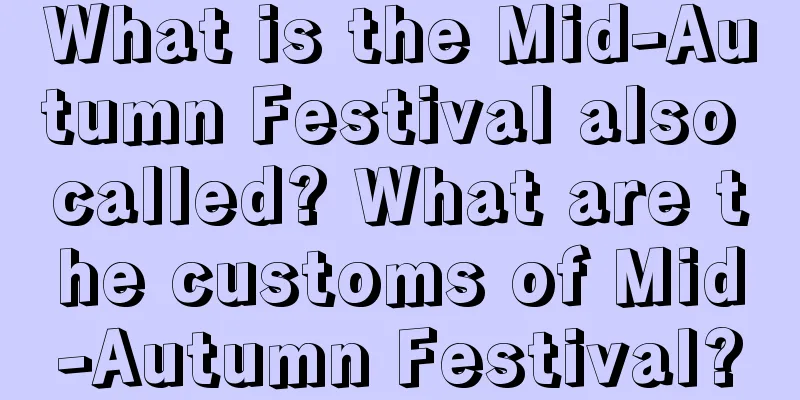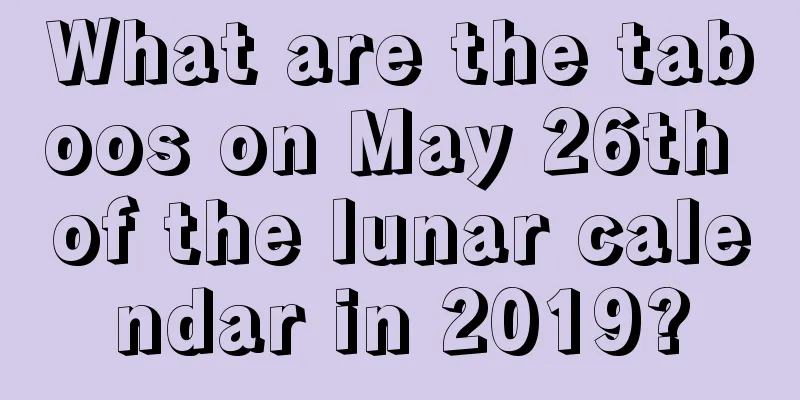What is the Mid-Autumn Festival also called? What are the customs of Mid-Autumn Festival?

The eighth month of the lunar calendar is already halfway through and we are welcoming the Mid-Autumn Festival. Want to know more about the Mid-Autumn Festival? The weather gradually gets cooler in the eighth month of the lunar calendar, the autumn breeze brings a refreshing coolness, and the sweet-scented osmanthus fills the air. If you want to know more about the lunar calendar for August 2021, please visit Shuimoxiansheng.com to find out!What is the Mid-Autumn Festival also called?The Mid-Autumn Festival, a traditional Chinese festival, originated from the worship of celestial phenomena and evolved from the ancient autumn moon worship. It is also known as the Moon Festival, Moonlight Birthday, Moon Eve, Autumn Festival, Mid-Autumn Festival, Moon Worship Festival, Moon Lady Festival, Moon Festival, Reunion Festival , etc.Moon Festival/Moon Worship Festival: In ancient times, there was an activity of worshiping the moon on the Autumnal Equinox, so the Mid-Autumn Festival is called "Moon Festival" or "Moon Worship Festival". August Festival/Mid-August: The Mid-Autumn Festival falls on August 15th, so it is called "August Festival" or "Mid-August". Moon Festival: The main activities of the Mid-Autumn Festival are all centered around the "moon", so it is also commonly known as the "Moon Festival". Reunion Festival: Because the moon is full during the Mid-Autumn Festival, it symbolizes reunion and gathering, so it is also called the "Reunion Festival." Moonlight Festival: In the Cantonese area, the Mid-Autumn Festival is commonly known as the "Moonlight Festival". Fruit Festival: In mid-autumn, various fruits and vegetables are ripe and available on the market, so it is called the "Fruit Festival". What are the customs of Mid-Autumn Festival?1. Guess the riddleOn the full moon night of the Mid-Autumn Festival, many lanterns are hung in public places, and people gather together to guess the riddles written on the lanterns. As this is a favorite activity for most young men and women, and love stories are also told during these activities, guessing lantern riddles has also evolved into a form of love between men and women. 2. Moon Festival Moon worship is a very old custom in our country. It is actually an activity of worship for the "Moon God" by the ancients. In ancient times, there was a custom of "watching the moon in the evening of autumn". Xiyue means worshiping the moon god. Since ancient times, in some parts of Guangdong, people have the custom of worshiping the Moon Goddess (worshiping the Moon Lady, worshiping the moonlight) on the night of the Mid-Autumn Festival. People worship the moon and set up a large incense table, placing moon cakes, watermelons, apples, red dates, plums, grapes and other offerings on it. Under the moon, the "Moon God" tablet is placed in the direction of the moon, red candles are lit, and the whole family worships the moon in turn, praying for blessings. 3. Light the lamp On the night of the Mid-Autumn Festival, there is a custom of lighting lanterns to help the moonlight. Nowadays, people in the Huguang area still have the custom of stacking tiles into a tower and lighting lanterns on the tower. In the Jiangnan area, there is a festival custom of making lantern boats. In modern times, the custom of lighting lanterns during the Mid-Autumn Festival has become more popular. Lanterns are usually made with bamboo strips to create a frame, and are made into shapes of fruits, birds, animals, fish, insects, and words such as "Celebrate Mid-Autumn Festival", and are then pasted with colored paper and painted in various colors. On the night of Mid-Autumn Festival, candles are lit in lanterns tied with ropes to bamboo poles and erected high on the eaves or terraces. Small lanterns are also used to form words or various shapes and hung high up in the house, commonly known as "Tree Mid-Autumn Festival" or "Vertical Mid-Autumn Festival". 4. Moon-watching The custom of moon-watching originated from the moon-worshipping ceremony, and the solemn worship turned into a relaxing entertainment. It is said that the moon is closest to the earth on this night and is the largest, roundest and brightest, so there has been a custom of feasting and appreciating the moon since ancient times. A daughter-in-law who returns to her parents' home must return to her husband's home on this day to symbolize perfection and auspiciousness. Written records of folk activities of watching the moon during the Mid-Autumn Festival appeared in the Wei and Jin Dynasties, but it did not become a custom. By the Tang Dynasty, appreciating and playing with the moon during the Mid-Autumn Festival was quite popular, and many famous poems by poets contain verses about the moon. 5. Listen to the incense Listening to incense is an ancient Mid-Autumn Festival custom that has been popular in Taiwan. In ancient times, young girls who wanted to find a good partner would first burn incense and worship before the gods at home, tell their worries, and pray to the gods to point them in the direction of the incense. Then, they would follow the direction indicated and remember the first words they heard accidentally or overheard on the road. When they got home, they would throw the dice to judge whether the divination was good or bad. For example, when divining about life events, if you hear things like eating sweet cakes, blooming flowers, or a full moon, it means a good omen and happiness is approaching. 6. Burning incense sticks In Jiangsu, people burn incense sticks on Mid-Autumn Festival night. The incense burner is covered with gauze and painted with the scenery of the Moon Palace. There are also incense burners made of incense sticks, with paper-made Kuixing (the star of heaven) and colorful flags inserted on them. There is also a custom of burning incense in Shanghai folks. 7. Vertical Mid-Autumn Festival In some places in Guangdong, there is an interesting traditional custom during the Mid-Autumn Festival called "Tree Mid-Autumn Festival". "Shu" (tree) also means "vertical", which means the lanterns are erected high, so it is also called "Vertical Mid-Autumn Festival". With the help of their parents, the children make rabbit lanterns, star fruit lanterns or square lanterns out of bamboo paper, hang them horizontally on short poles, and then erect them on tall poles. When they are held high, the colorful lights shine, adding another scene to the Mid-Autumn Festival. The children often compete with each other to see who can put up the tallest, most, and most exquisite lanterns. At night, the whole city is lit up like stars, competing with the bright moon in the sky to celebrate the Mid-Autumn Festival. 8. Playing Lu Zai "Shua Lu Zai" was a very popular children's game during the Mid-Autumn Festival in the past. A pomelo shell was used to carve a pattern with a lantern hung in the middle. Children would play in groups, or carry lanterns in the shapes of animals, melons and fruits, and walk along the street, singing "Shua Lu Zai, Shua Lu Er, light the lanterns. Those who know culture value culture, reading is the most important thing in the world, don't say that articles are useless, as the ancients said, a word is worth a thousand gold, and noble people will come from books..." After having fun, the children would disperse and go home to eat moon cakes, fruits and the like. 9. Play with Rabbit God The custom of playing with rabbit gods began around the end of the Ming Dynasty and was popular in Beijing. Ji Kun of the Ming Dynasty wrote in "The Remaining Drafts of Huawangge": "During the Mid-Autumn Festival in Beijing, people often make clay figures of rabbits, which are dressed and sit like humans, and are worshipped by children." By the Qing Dynasty, the function of the Rabbit God had changed from offering sacrifices to the moon to becoming a Mid-Autumn Festival toy for children. The rabbit god is made of clay, with a rabbit head and a human body. He is wearing armor and a back flag. His face is covered with gold clay and his body is painted. He may be sitting or standing, pounding a pestle or riding an animal, with two big ears erect, looking both solemn and humorous. "Yanjing Sui Shi Ji" records: "Every Mid-Autumn Festival, the skillful people in the market use yellow clay to make toad and rabbit images and sell them. They are called Rabbit Gods." Do you want to know your own Bazi? Want to figure out where your golden marriage is? Click on the [Premium Calculation] below to calculate your horoscope and fortune! |
Recommend
Can I move house on the day of Lesser Heat in 2020, the Gengzi Year? What does Lesser Heat mean?
"Shu" means hot, and "Xiaoshu"...
Is it suitable to get a haircut on November 17th of the lunar calendar in 2019? Is it okay to get a haircut?
Is it suitable to get a haircut on November 17th o...
Is it possible to get married on the eighth day of the tenth lunar month in the Year of the Rat 2020?
The wind in the tenth month of the lunar calendar...
Is the fate of a boy born on the third day of the first lunar month in 2021 strong? What is his personality like if he was born today?
Introduction: The fate of people born on each day ...
Is the fourth day of the ninth lunar month in 2019 a good day? Is it an auspicious day?
Is the fourth day of the ninth lunar month in 2019...
2020 Lunar New Year 19th Hour Auspicious and Unlucky Query, Hour Auspicious and Unlucky Query
Check the auspicious and inauspicious times and t...
Can I get married on July 17th of the lunar calendar in 2018?
The seventh month of the lunar calendar is full o...
Is it possible to get engaged in the heavy snow of 2018? How about getting engaged?
What is engagement? It basically means that the co...
The location of the God of Wealth on September 21, 2020
An overview of the God of Wealth's location o...
What solar terms are there in October of the lunar calendar in 2019? Recommended auspicious days for moving in October of the lunar calendar in 2019!
Introduction: There is a corresponding solar term ...
List of auspicious days for caesarean section in November of the lunar calendar in 2021
The eleventh month of the lunar calendar is also k...
Query—What are the do’s and don’ts on March 14, 2020?
Knowing the daily lunar calendar related matters ...
Is the 26th day of the sixth lunar month in 2017 a suitable day for opening a new store?
Introduction: Everyone who opens a store hopes tha...
Can I go back to my parents’ home on the Cold Food Festival, the day before Qingming Festival in 2020? When is the Cold Food Festival in 2020?
Introduction: You have to choose an auspicious day...
Recommended auspicious days for starting construction in November of the lunar calendar in 2020. What should you pay attention to when breaking ground?
Introduction: Generally, it is necessary to choose...









